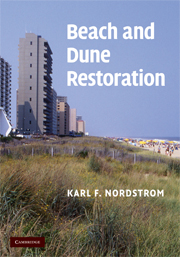Book contents
- Frontmatter
- Contents
- Preface
- Acknowledgments
- 1 The need for restoration
- 2 Beach nourishment and impacts
- 3 Dune building practices and impacts
- 4 Restoring processes, structure, and functions
- 5 Options in spatially restricted environments
- 6 A locally based program for beach and dune restoration
- 7 Stakeholder interests, conflicts, and co-operation
- 8 Research needs
- References
- Index
2 - Beach nourishment and impacts
Published online by Cambridge University Press: 14 August 2009
- Frontmatter
- Contents
- Preface
- Acknowledgments
- 1 The need for restoration
- 2 Beach nourishment and impacts
- 3 Dune building practices and impacts
- 4 Restoring processes, structure, and functions
- 5 Options in spatially restricted environments
- 6 A locally based program for beach and dune restoration
- 7 Stakeholder interests, conflicts, and co-operation
- 8 Research needs
- References
- Index
Summary
The potential for restoration
Many natural values and human–nature relationships that are lost in the process of converting natural coasts to developed coasts can be regained by nourishing beaches with compatible sediment and allowing natural processes to re-establish landforms and biota (Figure 2.1). Beach nourishment (also termed recharge, replenishment, or fill) has both positive and negative impacts (Table 2.1). Benefits to natural systems are not automatic byproducts of nourishment operations because nourished beaches may be built too high and wide to allow natural wave and swash processes to rework the backshore or they may be graded flat to enhance recreation, thereby eliminating the opportunity for naturally functioning landforms to evolve (Figure 1.1). Exotic sediments can change the morphology, chemical composition, and evolutionary trend of the beach. If dunes are included in designs, they are often built as linear dikes by earth-moving equipment rather than by aeolian processes (Figure 1.2). Beach nourishment is often called beach restoration but beaches are not restored simply by placing a volume of sediment on a coast (Nordstrom 2000).
The considerable shore protection and recreational values of nourished beaches are well documented (Dean 2002; Gómez-Pina et al. 2004; Reid et al. 2005). This book focuses on the way existing management practices can be evaluated and modified to achieve restoration goals. No attempt is made to provide guidelines for traditional fill practices, evaluate fill longevity, discuss the social or economic advantages and disadvantages, or evaluate the long-term feasibility of beach nourishment projects.
- Type
- Chapter
- Information
- Beach and Dune Restoration , pp. 19 - 48Publisher: Cambridge University PressPrint publication year: 2008



